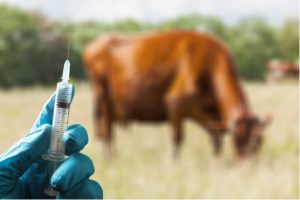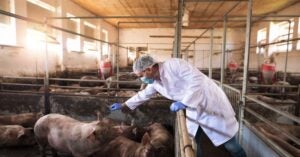Many diseases have huge impacts on animal agriculture. However, there have been efforts to eradicate animal diseases for years, and disease eradication is important to keep both animals and humans safe and healthy.
Some organizations are devoted to protecting animal health, and part of that includes eradicating diseases. The World Organization for Animal Health led the global eradication of Rinderpest in 2011. This is the first animal disease to be completely eradicated across the globe; WOAH continues to outline policies to prevent and eradicate Rinderpest in the event that it is seen again. WOAH has also outlined strategies and is working to eradicate African Swine Fever, bovine tuberculosis, foot and mouth disease, peste des petits ruminants, and rabies from around the world.
In the United States, the U.S. Department of Agriculture’s Animal and Plant Health Inspection Service is working to eradicate many diseases, including cattle brucellosis, swine brucellosis, bovine and cervid tuberculosis, pseudorabies, and scrapie. APHIS has many programs in place to eradicate diseases, develop disease management strategies, provide important information and updates to the public, and more. Each state also has a state veterinarian. These state departments also have their own goals for disease eradication and work with APHIS to accomplish nationwide goals.

Vaccination programs are one tool to eradicate diseases. Animal agriculture relies heavily on vaccination programs to prevent and control diseases among livestock. By vaccinating animals against various pathogens, farmers and ranchers not only protect the health and welfare of their livestock but also prevent the transmission of diseases to humans. Vaccinations are also important to farmers and ranchers for economic and animal welfare reasons. There are new vaccinations in development all the time. Vaccine research aims to improve the effectiveness of vaccines and create new vaccines to protect animals against new and different diseases.
Disease monitoring and surveillance are other key strategies to eradicate diseases. Regular disease monitoring allows farmers and veterinarians to detect any outbreaks early on, implement control measures when needed, and prevent the spread of diseases. These surveillance efforts are not only essential for animal welfare but also contribute to public health by reducing the risk of zoonotic diseases. The National Animal Health Surveillance System works to detect threats to animal health in a timely manner. APHIS also watches for diseases in wild animals. This is important because some diseases can be transferred from wild animals to domesticated livestock.
Biosecurity is another important way to control and eradicate diseases. Biosecurity is how we prevent diseases from being transferred to people, animals, and properties. The goal of biosecurity is to keep diseases off farms and/or prevent them from spreading further.

The USDA’s National Institute of Food and Agriculture runs agricultural biosecurity programs. These programs accomplish some of the same goals as APHIS, with both programs working to detect diseases, share resources and information with the public, and create new disease management strategies.
While NIFA works nationwide, many individual farms and ranches have biosecurity measures to help eradicate disease. These measures include washing down each vehicle that enters a farm’s property, only allowing in authorized visitors, and even ensuring that each person entering a facility showers before and after visiting a bio-secure location. Other common biosecurity measures include having clean facilities, following a veterinarian-approved vaccination program, providing fresh food and water to animals, and having separate housing for sick or susceptible animals away from the general population. When new animals enter the facility (or return after events like a county fair), they are often quarantined for two weeks to watch for any signs of disease or illness.
Sick animals can be reported to a farmer’s local veterinarian, extension office, or even state and federal veterinarians (depending on the symptoms), who can provide support and guidance. If the animal’s symptoms match a disease that APHIS monitors closely, state and federal veterinarians will get involved to report, monitor, and handle the situation.
There are many ways that animal agriculture works to eradicate diseases. These methods include vaccination programs, disease monitoring and surveillance, and biosecurity measures. Disease prevention and eradication continue to be important at the state, national, and global levels. These efforts are key to improving animal health, animal welfare, and economics for farmers and ranchers, and even for protecting human health.
Michelle Miller, the Farm Babe, is a farmer, public speaker, and writer who has worked for years with row crops, beef cattle, and sheep. She believes education is key in bridging the gap between farmers and consumers.



